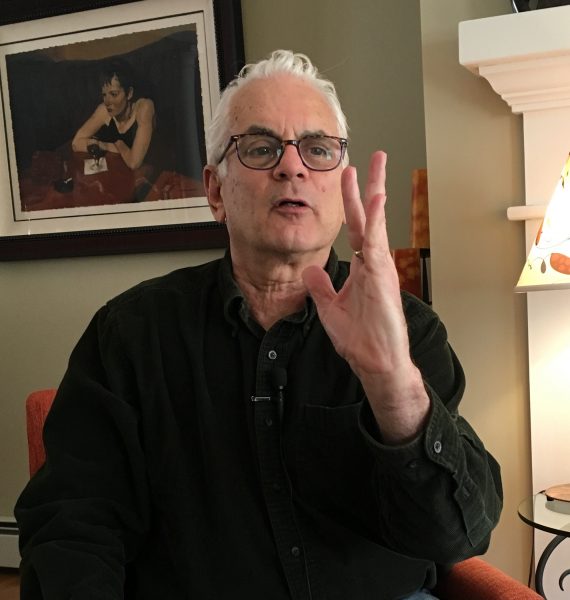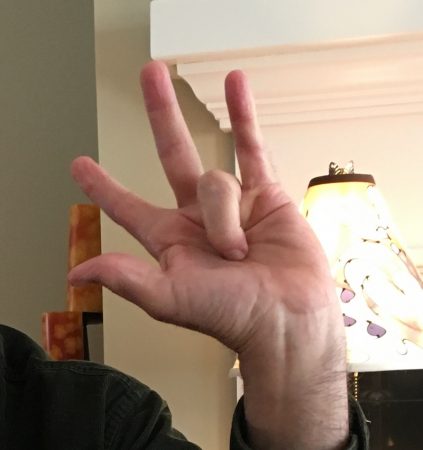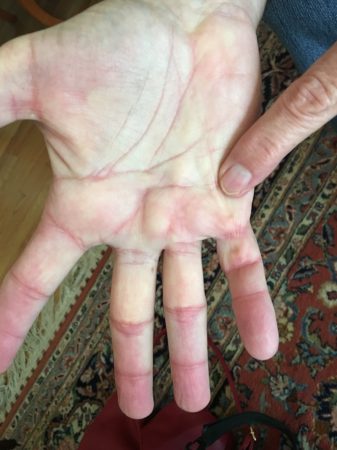About 12 years ago, Donald Jones ran into an old friend who used to be a hand surgeon. When they shook hands, the friend felt a cord in Donald’s palm and told him that he had Dupuytren’s contracture.
When you have Dupuytren’s, you can’t straighten some of your fingers, usually the ring and/or the little finger and sometimes, the thumb. Donald knew what it was. His father had had a contracture in one of his fingers. He waited until it was really bad before doing anything.
He didn’t do anything about it until his finger curled over and grew right into his palm. He had to have major surgery back in the 80s. They had to cut the cords in his hand to open up his fingers and he was in the hospital for two or three days.
Donald Jones
How Dupuytren’s develops
Right underneath the skin on your palm is a sheet of connective tissue called the fascia. In fact, there is a sheet of fascia underneath all of our skin. It helps reinforce and protect the skin, as well as stabilize muscles, tissues, and organs.

With Dupuytren’s, for unknown reasons, the fascia becomes diseased. The first sign is usually a small nodule or a bump in the palm, says Dr. Youssra Marjoua, an orthopaedic surgeon and hand specialist at OA Centers for Orthopaedics in Portland, Maine.
It may feel like a callous. There’s no pain, but it continues to evolve into a cord. The cord doesn’t immediately contract but eventually will attach to the skin above. As that happens, it starts to actually bring the skin down and leads to a flexed finger.
The highest prevalence is in senior Caucasian men, mostly with blue or green eyes and of northern European descent. They usually have a family history of the condition. The risk increases with age.
Youssra Marjoua, MD

Donald’s probably began in his 60s. He’s now 73. It progressed slowly in both ring fingers. Thankfully, they were never as curled over as his father’s. They still presented a problem.
I would shake hands and it would feel funny. Your finger has curled over and you can’t even force it back.
Donald
In April 2018 he had a procedure to release the cords and his bent fingers, first in one hand and a month later, the other. He could have opted for surgery to remove the diseased fascia, but instead, decided to have an enzyme called Xiaflex injected directly into the cord. The enzyme softens and weakens the cord so that in a day or two it’s possible to break it up by stretching and bending the finger back. In one finger, Donald inadvertently did it on his own.
I had the shot one day and the next day I was shopping and I went to return some bottles. Without thinking, I grabbed the door of the bottle return to drop the bottles in and I felt it pull a little bit. I didn’t think much of it because there was a bandage all over it. When I went in that next day to have it stretched, he said, oh, you already did it. So that pulling already stretched it some and then he did the rest.
Donald
Donald said when he got the enzyme shot it hurt because he could feel the needle moving around. Inserting a needle into the cord and moving it around can also help to free it up. The technique is called needling.
When he returned, the area was numbed, but as the doctor stretched his finger, he could feel a pulling sensation — more uncomfortable than painful. When the first finger was done, the skin broke a little but not with the second one.
He says he’s glad he had the procedure done because his fingers are no longer bent. But he still has a bit of trouble opening jars and there’s a chance he’ll be having another procedure sometime in the future.
You can see that there’s another one coming. That’s a cord right there on my little finger. So if my finger starts to come over more then I’ll have to have it done.
Donald
Deciding how or if to treat
Dr. Marjoua says it’s difficult to predict the severity of the disease. Just because there is a nodule or even a cord doesn’t mean the finger will bend. To make a diagnosis, in addition to asking questions and examining your hand, the doctor will also do what’s called a tabletop test.
The tabletop test is basically putting your hand palm down on the table. If you can place all fingers and the entire surface of your palm down on the table without any gap it usually means your contraction, if there even is one, does not warrant any intervention.
Dr. Marjoua
If treatment is necessary, two factors should be considered before choosing surgery versus an injection.
One: Is there a clear palpable cord that you can inject the medicine safely into? You only want it in the diseased tissue and not in the tendon or surrounding arteries and nerves. If there’s a clear cord, you’re a candidate for injection
Two: It depends on the severity of contracture. If somebody has a finger and palm deformity, you can’t even see the cord to be able to inject it. That makes you a candidate for surgery.
Dr. Marjoua
Some people have the option of either surgery or injection. Because the diseased fascia is removed, there is less chance of a recurrence when you have surgery, but it usually can’t be totally removed, so it doesn’t eliminate the risk. Either way, there is no easy way to predict if there will be a recurrence
If you suspect you have Dupuytren’s, don’t wait until your finger is curled over to see a doctor. That piece of advice came from both Donald and Dr. Marjoua. The first sign of a lump in your palm may not be an emergency situation, but at least you’ll have a better understanding of what to expect and will be more likely to have a treatment choice if/when the time comes.
The American Academy of Orthopaedic Surgeons has more information about Dupuytren’s on its website.



The Dupuytren Research Group is hoping to find a cause and cure for Dupuytren. Please visit our website for more information on Dupuytren and related diseases: http://www.dupuytrens.org.